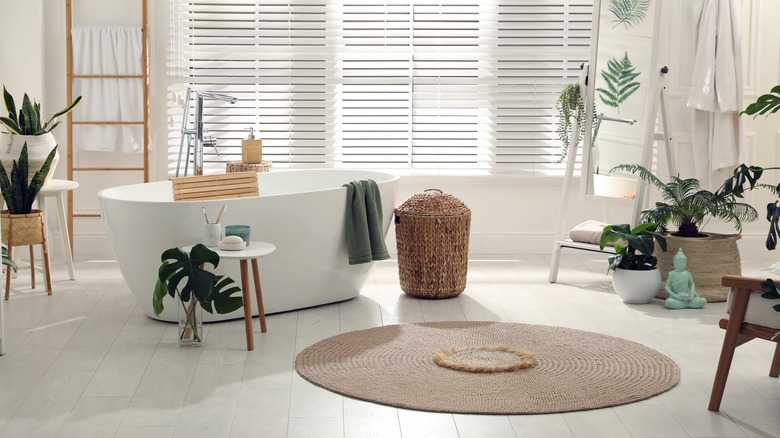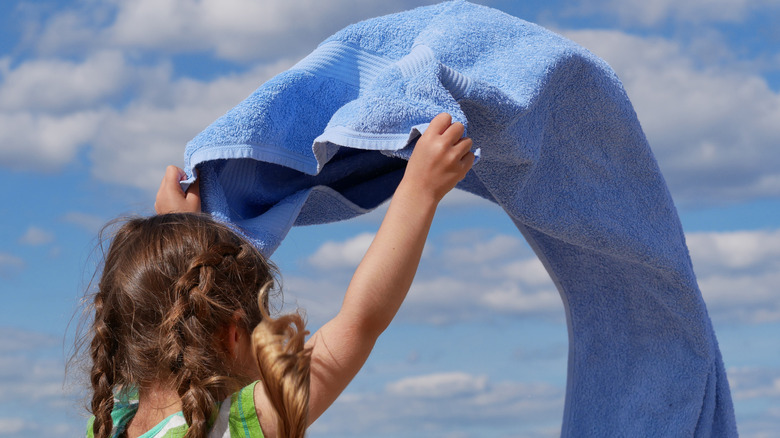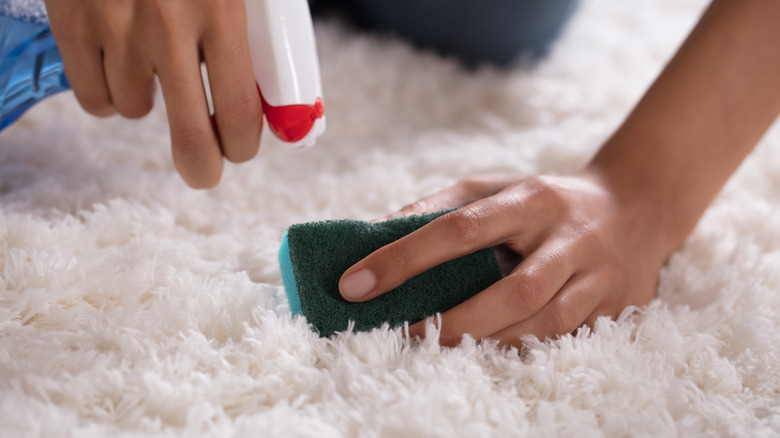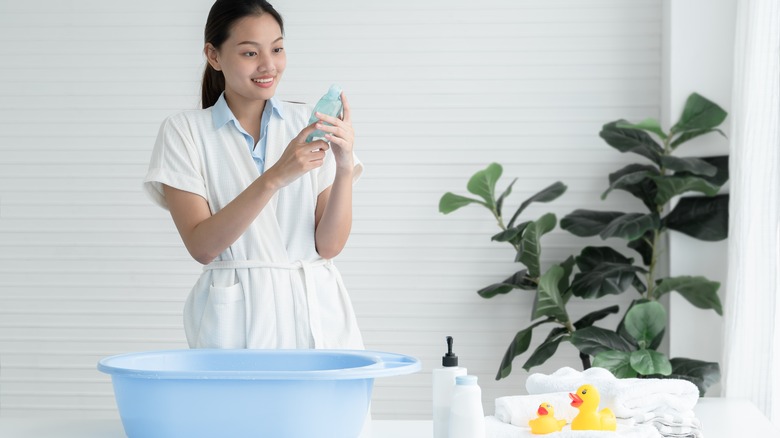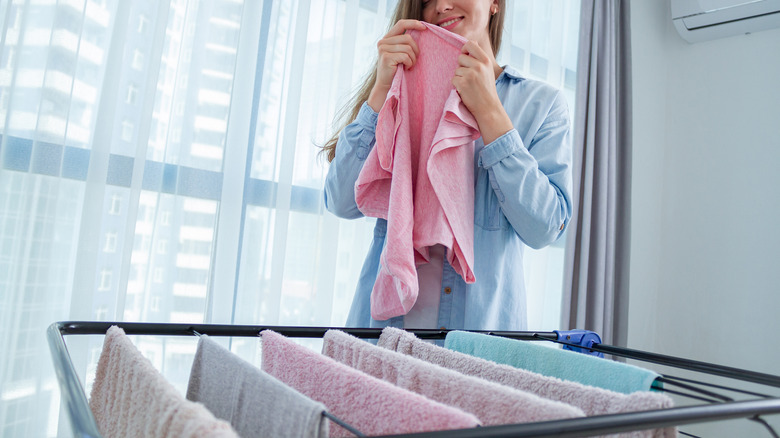4 Tips For Cleaning Your Bath Mat At Home
Areas of persistent dampness are always a risk for mold, bacteria, and mildew build-up; therefore, your bath mat is a potential petri dish for such unwelcome bathroom visitors, according to Wet & Forget. The downsides to allowing such harmful infestations are more than just bad smells and stains. They can potentially put your health at risk.
According to Martha Stewart, the frequency with which you ought to wash your bath mat will vary based on the level of use, airflow, and material. As Merry Maids pointed out, a mat being used by one or two people showering once a day, who are hanging the mat up to dry after use, can space washings out to every two or three weeks. However, a smelly bath mat is practically asking to be washed, and, as Rinse advised, a good rule of thumb is to wash your bath mat at the very least once every 10 days to prevent mildew building up.
Although they are simple, everyday items, bathmats are also specialized equipment that's designed for a specific purpose in our households — and as such, they can benefit from specific maintenance practices. These are simple steps that make all the difference when it comes to taking care of your bath mat. Our four tips for cleaning your bath mat at home will help you to get a thorough clean, sanitize your bathroom, and maximize the time before you need to rewash it.
Shake it off
A bath mat doesn't simply soak up water from above and pick up a bit of dust from the floor below. A lot of debris will fall onto the bath mat over time, including dust and hair. This is why, according to Express, it is imperative to take your bath mat to an appropriate place — ideally outside — and shake all accumulated detritus out. If you have some extra stress you would like to work out, consider hanging it up and using a stick or your hand to smack the bath mat a bit. According to The Maids, this is the ideal way to rid the bath mat of stubbornly embedded dirt and hair.
One of the benefits of making this the first thing you do when cleaning your bath mat at home is that it works no matter which material or type of bath mat you have. Bath mats can vary widely in terms of specific care requirements, but the rule of thumb that your first step needs to be removing loose particles is a good one.
As well as shaking and beating your bath mat, you could also consider brushing it, per Maid for You. Hopefully, a soft cleaning brush will be enough to remove most dry material from the mat, but if it is necessary, vacuum cleaning wouldn't be unreasonable. Dealing with as much dry dirt now as possible saves time and effort in the long run.
Spot treat stains
Not all of the dirt that falls onto your bath mat is going to be dry, loose, and easy to just shake, brush, or smack off. Liquids other than water soak into the mat, and some of these potential liquids can be brightly colored or chemically difficult to remove from fabric, such as makeup. Rather than putting these spots of dirt into soak with the rest of the mat and potentially spreading the stain further around, it's best to treat stains ahead of the full clean, ideally while they are still fresh, as this makes them easier to remove, according to the University of Illinois Extension.
Many bath mats have rubber backings, which can react with bleach in negative ways, and therefore there are a lot of people prefer not to use bleach to treat stains on their bath mats. However, according to Housewife How-Tos, classic homemade cleaning solutions such as vinegar can also react with rubber. Using those chemicals on rubber can cause it to get brittle and damage easily, which can impact how long your bath mat will last before needing to be replaced, so it is advisable to use oxygenated bleach as an alternative stain remover.
Read the labels carefully
Once surface dirt and stubborn stains have been dealt with, it is time to tackle the meat of the problem, refreshing your bath mat with an overall clean that removes any chance of mildew and bacteria building up in or underneath the bathmat. There are several ways of doing this. The easiest is to put the bathmat in the washing machine — according to Oh So Spotless, hand-wash-only rugs are a rarity these days. However, it is important to ensure that your bath mat can handle the products and techniques you plan to use, so read the label on both the mat and the products!
According to Cleanipedia, the key to eliminating bacteria and mildew from fabric bath mats is washing them using the highest-temperature setting the fabric is comfortable with to sterilize them. If you are having persistent problems with infestations of this kind, adding ½ cup of Borax to your load the next time you wash your bath mat will help with disinfection.
High temperatures and alkaline environments are excellent at killing unwanted bacteria or mold, but not all fabrics can take that kind of treatment. According to Love to Know, if your bath mat is made from natural fibers — wool, bamboo, or jute, for example — then it is probably better to hand wash them. Just take extra care to use products that will disinfect thoroughly as the temperatures will be lower than using a machine.
Dry your bath mat thoroughly
According to The Mold Medic, it takes 24 hours for a mold spore to begin growing. Typically moisture is enough to get mold spores to start to form a colony, especially on bath mats.
If you hang your bath mat up and have good ventilation, there's little chance of the mat being wet for 24 hours, long enough for a mold colony to form, during normal use. But, when you clean your bath mat, that's the wettest it gets, and it's important that you ensure the mat gets entirely dry at this stage. After cleaning, there will be a lot more moisture soaked into the bath mat, which will take a lot longer to dry out fully, and this could put your mat in the danger zone for mold growth. This is why Upstairs Downstairs Cleaning Service suggested using a tumble dryer on a low setting if that's possible for the fabric your bath mat is made of.
However, if the weather is nice and breezy, House Cleaning Central simply suggested taking the bath mat out into the elements, hanging it on a washing line or over the back of a chair, and letting the air and sunshine do their work.
